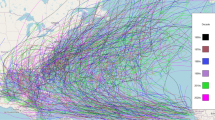Abstract
The authors demonstrate a spatial framework for studying hurricane climatology. The framework consists of a spatial tessellation of the hurricane basin using equal-area hexagons. The hexagons are efficient at covering hurricane tracks and provide a scaffolding to combine attribute data from tropical cyclones with spatial climate data. The framework’s utility is demonstrated using examples from recent hurricane seasons. Seasons that have similar tracks are quantitatively assessed and grouped. Regional cyclone frequency and intensity variations are mapped. A geographically-weighted regression of cyclone intensity on sea-surface temperature emphasizes the importance of a warm ocean in the intensification of cyclones over regions where the heat content is greatest. The largest differences between model predictions and observations occur near the coast. The authors suggest the framework is ideally suited for comparing tropical cyclones generated from different numerical simulations.













Similar content being viewed by others
Notes
NOAA/OAR/ESRL PSD, Boulder, Colorado, USA (http://www.esrl.noaa.gov/psd/).
References
Anselin L, Syabri I, Kho Y (2006) GeoDa: an introduction to spatial data analysis. Geogr Anal 38(1):5–22, Symposium on spatial information science for Human and Social Science, Tokyo, Japan, Jan 2004
Birch CP, Oom SP, Beecham JA (2007) Rectangular and hexagonal grids used for observation, experiment and simulation in ecology. Ecol Modell 206(3–4) doi:10.1016/j.ecolmodel.2007.03.041
Bivand R, Pebesma E, Gomez-Rubio V (2008) Applied spatial data analysis with R. Springer, New York
Brettschneider B (2008) Climatological hurricane landfall probability for the United States. J Appl Meteorol Climatol 47(2):704–716. doi:10.1175/2007JAMC1711.1
Brunsdon C, Fotheringham S, Charlton M (1998) Geographically weighted regression–modelling spatial non-stationarity. J R Stat Soc Ser D, Stat 47(Part 3):431–443, Workshop on Local Indicators of Spatial Association, Leicester, England, Jun 1996
Camargo SJ, Robertson AW, Gaffney SJ, Smyth P, Ghil M (2007) Cluster analysis of typhoon tracks. Part I: General properties. J Clim 20(14):3635–3653. doi:10.1175/JCLI4188.1
Chand SS, Walsh KJE (2009) Tropical cyclone activity in the fiji region: Spatial patterns and relationship to large-scale circulation. J Clim 22(14):3877–3893. doi:10.1175/2009JCLI2880.1
Compo GP, Whitaker JS, Sardeshmukh PD (2006) Feasibility of a 100-year reanalysis using only surface pressure data. Bull Am Meteorol Soc 87(2):175+. doi:10.1175/BAMS-87-2-175
de Beurs KM, Henebry GM (2008) Northern annular mode effects on the land surface phenologies of northern Eurasia. J Clim 21(17):4257–4279. doi:10.1175/2008JCLI2074.1
Elsner JB (2003) Tracking hurricanes. Bull Am Meteorol Soc 84(3):353–356. doi:10.1175/BAMS-84-3-353
Elsner JB, Jagger TH (2006) Prediction models for annual US hurricane counts. J Clim 19(12):2935–2952
Elsner JB, Jagger TH (2010) On the increasing intensity of the strongest Atlantic hurricanes. In: Elsner JB, Hodges RE, Malmstadt JC, Scheitlin KN (eds) Hurricanes and climate change, vol 2, Springer, New York, chap 10 doi:10.1007/978-90-481-9510-7
Elsner JB, Kara AB (1999) Hurricanes of the North Atlantic: climate and society. Oxford University Press, USA
Elsner JB, Liu Kb (2003) Examining the ENSO-typhoon hypothesis. Clim Res 25(1):43–54
Elsner JB, Niu XF, Jagger TH (2004) Detecting shifts in hurricane rates using a Markov chain Monte Carlo approach. J Clim 17(13):2652–2666
Elsner JB, Kossin JP, Jagger TH (2008) The increasing intensity of the strongest tropical cyclones. Nature 455(7209):92–95. doi:10.1038/nature07234
Elsner JB, Jagger TH, Fogarty EA (2009) Visibility network of United States hurricanes. Geophys Res Lett 36 doi:10.1029/2009GL039129
Fotheringham AS, Brunsdon C, Charlton M (2000) Quantitative geography: perspectives on spatial data analysis. Sage, London
Hope J, Neumann C (1971) Digitized atlantic tropical cyclone tracks. Tech. Memo to the National Weather Service, National Oceanic and Atmospheric Administration
Jagger TH, Elsner JB (2006) Climatology models for extreme hurricane winds near the United States. J Clim 19(13):3220–3236
Jagger TH, Niu XF, Elsner JB (2002) A space-time model for seasonal hurricane prediction. Int J Climatol 22(4):451–465. doi:10.1002/joc.755
Jarvinen BR, Neumann CJ, Davis MAS (1984) A tropical cyclone data tape for the north atlantic basin, 1886–1983: Contents, limitations, and uses. Technical Memo. 22, NOAA NWS NHC
Joyner TA, Rohli RV (2010) Kernel density estimation of tropical cyclone frequencies in the North Atlantic basin. Int J Geosci 1:121–129. doi:10.4236/ijg.2010.13016
Landsea CW, Vecchi GA, Bengtsson L, Knutson TR (2010) Impact of duration thresholds on Atlantic tropical cyclone counts. J Clim 23(10):2508–2519. doi:10.1175/2009JCLI3034.1
Malmstadt JC, Elsner JB, Jagger TH (2010) Risk of strong hurricane winds to Florida cities. J Appl Meteorol Climatol 49:2121–2132
Moran PAP (1950) Notes on continuous stochastic phenomena. Biometrika 37:17–33
Nakamura J, Lall U, Kushnir Y, Camargo SJ (2009) Classifying North Atlantic tropical cyclone tracks by mass moments. J Clim 22(20):5481–5494. doi:10.1175/2009JCLI2828.1
Randall D, Heikes R, Ringler TD (2000) General circulation model development: past, present, & future. Academic Press, chap Global atmospheric modeling using a geodesic grid with an isentropic vertical coordinate., pp. 509–538
Scheitlin KN, Elsner JB, Malmstadt JC, Hodges RE, Jagger TH (2010) Toward increased utilization of historical hurricane chronologies. J Geophys Res Atmos 115 doi:10.1029/2009JD012424
Smith TM, Reynolds RW, Peterson TC, Lawrimore J (2008) Improvements to NOAAs historical merged Land Ocean surface temperature analysis (1880–2006). J Clim 21(10):2283–2296. doi:10.1175/2007JCLI2100.1
Villarini G, Vecchi GA, Smith JA (2010) Modeling the dependence of tropical storm counts in the North Atlantic basin on climate indices. Mon Wea Rev 138(7):2681–2705
Whitaker JS, Compo GP, Wei X, Hamill TM (2004) Reanalysis without radiosondes using ensemble data assimilation. Mon Weather Rev 132(5):1190–1200
Xie L, Yan TZ, Pietrafesa LJ, Morrison JM, Karl T (2005) Climatology and interannual variability of North Atlantic hurricane tracks. J Clim 18(24):5370–5381
Acknowledgments
The work was supported with contracts from the U.S. NSF under grant ATM0738172 and from the Strategic Environmental Research and Development Program under grant SERDP SI-1700.
Author information
Authors and Affiliations
Corresponding author
Rights and permissions
About this article
Cite this article
Elsner, J.B., Hodges, R.E. & Jagger, T.H. Spatial grids for hurricane climate research. Clim Dyn 39, 21–36 (2012). https://doi.org/10.1007/s00382-011-1066-5
Received:
Accepted:
Published:
Issue Date:
DOI: https://doi.org/10.1007/s00382-011-1066-5




